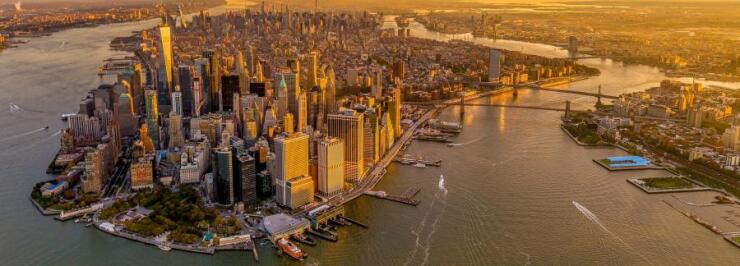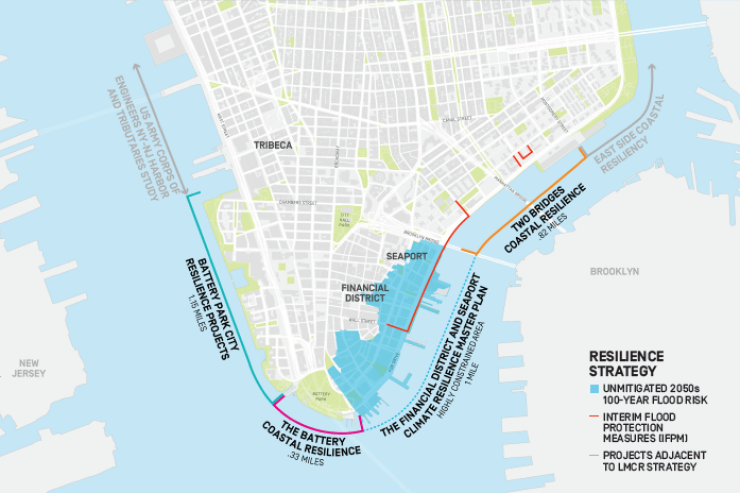New York Mayor Bill de Blasio's long game for his $10 billion Lower Manhattan resilience initiative hinges on a huge variable — whether large-scale federal funding will be available.
"From the perspective of the city of New York alone, this would be extraordinarily difficult to fund," de Blasio told reporters Thursday at Metropolitan College of New York on West Street.

De Blasio, citing the searing memory of Hurricane Sandy and the findings of a New York City Economic Development Corporation
"The security of Lower Manhattan should be a national priority," he added, referencing its large financial industry presence, convergence of subway lines and bursting population.
De Blasio said Democratic control of the White House and the Senate in the 2020 elections could change the dynamic, notably with Charles Schumer, D-N.Y., in line for the Senate presidency under such a scenario. The mayor has also played the party-control card in his call for the state legislature to pass a millionaire's tax to help fund mass transit.
"If there’s federal money in play, it probably looks one way," de Blasio said. "If there’s not federal money in play, we have to get some private money and there has to be some development. That to me is the dividing line."
The new proposal is a variant of Seaport City, which de Blasio predecessor Michael Bloomberg envisioned in 2013. De Blasio, though, sees development as a last resort while development was a linchpin of Bloomberg's plan.
Howard Cure, director of municipal bond research for Evercore Wealth Management, warned the city could be on the hook for much more.
"Monies from the federal government usually come after a disaster and now you're trying to be proactive here," Cure said.
"The city's contribution is just another part of their amazingly high tab that they're going to have to start issuing debt on," Cure said. "You cannot rely on the federal government for that, and even if the federal government were to give money through something like FEMA" — the Federal Emergency Management Agency — "a lot of times it's to restore the damage, it's not to make it protective."
De Blasio, Cure added, is burnishing his progressive reputation for a possible presidential run by aligning himself with the national New Green Deal movement.

Any request for additional federal dollars could clash against the proposed $30 billion Gateway tunnel project for funding and water access, said resilience expert Alan Rubin, a partner with Blank Rome LLP.
"The real difference is that [de Blasio's] got Gateway competing for those dollars," Rubin said. "There's already a commitment on the part of New Jersey and New York, and there's a federal portion that must be anted up."
According to Rubin, funding through the FAA Reauthorization Act of 2018, with its resilience and mitigation guidelines, could be more realistic.
"There is certainly a need and the ideas are well thought out," Rubin said of the de Blasio plan. Concerns beyond cost, he added, include a variety of mult-istate jurisdictional complexities. "Storm surge doesn't distinguish between states. Hoboken [N.J.], Manhattan ... all of these folks have to be engaged."
Other variables include the request-for-proposals process. "Do you use the Danish models of all government monies and if you include private funding how does the ownership become handled?"
The city intends to spend $5 million to $10 million from this year's operating budget to start the master planning process, according to NYEDC President James Patchett.
"This piece, around the Seaport, around the Financial District, is unfortunately the worst of all worlds because it is where there are so many jobs, subway lines, everything we’ve talked about, people more and more living there, and it’s the lowest part of the whole shoreline," de Blasio said.
Lower Manhattan's population has spiked to 75,000. That, and a tourist explosion in the mixed-use area, have caused widespread street congestion and related problems. The proximity of FDR Drive, the Battery tunnel and the Cranberry Street tunnel, which carries the A and C subway lines, further constrain the sites.
"It’s the most vulnerable, and that’s why we need this extraordinary barrier," the mayor said.
For now, the city will advance $500 million for four capital projects to reinforce Lower Manhattan’s coastal areas and provide interim flood protections for the Seaport, parts of the Financial District and Two Bridges neighborhoods, to begin construction between 2019 and 2021.
In the South Street Seaport area, parts of the Financial District and Two Bridges neighborhoods, the city's Emergency Management unit will spend $3.5 million to deploy a combination of Tiger Dams and pre-deployed Hesco barriers by the hurricane season as temporary measures.
Also, the Battery Park City Authority will reconstruct its esplanade and open space to adapt to new climate conditions with $134 million of bonds. The authority kicked off design in 2018 and expects to start construction in 2020.
In the Battery, the New York City EDC, in partnership with the Parks and Recreation Department, Battery Park City Authority and the Battery Conservancy, will invest $165 million to elevate the wharf and esplanade and integrate a protective barrier, such as a berm, at the back of the park. Construction is expected in 2021.
In the Two Bridges neighborhood, the EDC is designing an integrated flood protection system composed of permanent barriers and deployable or "flip-up" protections that will protect view corridors and public access. The EDC will manage construction of the $200 million investment, which will begin in 2021.





